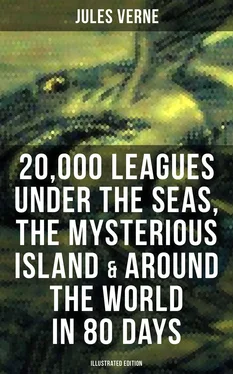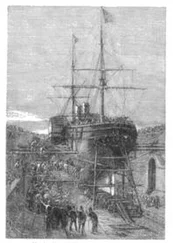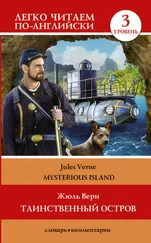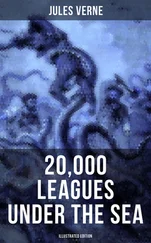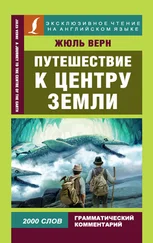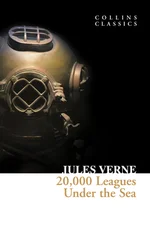Conseil kept Ned under observation. The harpooner walked in the lead, and during his stroll through this forest, he gathered with sure hands some excellent fruit that should have completed his provisions.
“So,” Conseil asked, “you have everything you need, Ned my friend?”
“Humph!” the Canadian put in.
“What! You’re complaining?”
“All this vegetation doesn’t make a meal,” Ned replied. “Just side dishes, dessert. But where’s the soup course? Where’s the roast?”
“Right,” I said. “Ned promised us cutlets, which seems highly questionable to me.”
“Sir,” the Canadian replied, “our hunting not only isn’t over, it hasn’t even started. Patience! We’re sure to end up bumping into some animal with either feathers or fur, if not in this locality, then in another.”
“And if not today, then tomorrow, because we mustn’t wander too far off,” Conseil added. “That’s why I propose that we return to the skiff.”
“What! Already!” Ned exclaimed.
“We ought to be back before nightfall,” I said.
“But what hour is it, then?” the Canadian asked.
“Two o’clock at least,” Conseil replied.
“How time flies on solid ground!” exclaimed Mr. Ned Land with a sigh of regret.
“Off we go!” Conseil replied.
So we returned through the forest, and we completed our harvest by making a clean sweep of some palm cabbages that had to be picked from the crowns of their trees, some small beans that I recognized as the “abrou” of the Malaysians, and some high-quality yams.
We were overloaded when we arrived at the skiff. However, Ned Land still found these provisions inadequate. But fortune smiled on him. Just as we were boarding, he spotted several trees twenty-five to thirty feet high, belonging to the palm species. As valuable as the artocarpus, these trees are justly ranked among the most useful produce in Malaysia.
They were sago palms, vegetation that grows without being cultivated; like mulberry trees, they reproduce by means of shoots and seeds.
Ned Land knew how to handle these trees. Taking his ax and wielding it with great vigor, he soon stretched out on the ground two or three sago palms, whose maturity was revealed by the white dust sprinkled over their palm fronds.
I watched him more as a naturalist than as a man in hunger. He began by removing from each trunk an inch-thick strip of bark that covered a network of long, hopelessly tangled fibers that were puttied with a sort of gummy flour. This flour was the starch-like sago, an edible substance chiefly consumed by the Melanesian peoples.
For the time being, Ned Land was content to chop these trunks into pieces, as if he were making firewood; later he would extract the flour by sifting it through cloth to separate it from its fibrous ligaments, let it dry out in the sun, and leave it to harden inside molds.
Finally, at five o’clock in the afternoon, laden with all our treasures, we left the island beach and half an hour later pulled alongside the Nautilus. Nobody appeared on our arrival. The enormous sheet-iron cylinder seemed deserted. Our provisions loaded on board, I went below to my stateroom. There I found my supper ready. I ate and then fell asleep.
The next day, January 6: nothing new on board. Not a sound inside, not a sign of life. The skiff stayed alongside in the same place we had left it. We decided to return to Gueboroa Island. Ned Land hoped for better luck in his hunting than on the day before, and he wanted to visit a different part of the forest.
By sunrise we were off. Carried by an inbound current, the longboat reached the island in a matter of moments.
We disembarked, and thinking it best to abide by the Canadian’s instincts, we followed Ned Land, whose long legs threatened to outpace us.
Ned Land went westward up the coast; then, fording some stream beds, he reached open plains that were bordered by wonderful forests. Some kingfishers lurked along the watercourses, but they didn’t let us approach. Their cautious behavior proved to me that these winged creatures knew where they stood on bipeds of our species, and I concluded that if this island wasn’t inhabited, at least human beings paid it frequent visits.
After crossing a pretty lush prairie, we arrived on the outskirts of a small wood, enlivened by the singing and soaring of a large number of birds.
“Still, they’re merely birds,” Conseil said.
“But some are edible,” the harpooner replied.
“Wrong, Ned my friend,” Conseil answered, “because I see only ordinary parrots here.”
“Conseil my friend,” Ned replied in all seriousness, “parrots are like pheasant to people with nothing else on their plates.”
“And I might add,” I said, “that when these birds are properly cooked, they’re at least worth a stab of the fork.”
Indeed, under the dense foliage of this wood, a whole host of parrots fluttered from branch to branch, needing only the proper upbringing to speak human dialects. At present they were cackling in chorus with parakeets of every color, with solemn cockatoos that seemed to be pondering some philosophical problem, while bright red lories passed by like pieces of bunting borne on the breeze, in the midst of kalao parrots raucously on the wing, Papuan lories painted the subtlest shades of azure, and a whole variety of delightful winged creatures, none terribly edible.
However, one bird unique to these shores, which never passes beyond the boundaries of the Aru and Papuan Islands, was missing from this collection. But I was given a chance to marvel at it soon enough.
After crossing through a moderately dense thicket, we again found some plains obstructed by bushes. There I saw some magnificent birds soaring aloft, the arrangement of their long feathers causing them to head into the wind. Their undulating flight, the grace of their aerial curves, and the play of their colors allured and delighted the eye. I had no trouble identifying them.
“Birds of paradise!” I exclaimed.
“Order Passeriforma, division Clystomora,” Conseil replied.
“Partridge family?” Ned Land asked.
“I doubt it, Mr. Land. Nevertheless, I’m counting on your dexterity to catch me one of these delightful representatives of tropical nature!”
“I’ll give it a try, professor, though I’m handier with a harpoon than a rifle.”
Malaysians, who do a booming business in these birds with the Chinese, have various methods for catching them that we couldn’t use. Sometimes they set snares on the tops of the tall trees that the bird of paradise prefers to inhabit. At other times they capture it with a tenacious glue that paralyzes its movements. They will even go so far as to poison the springs where these fowl habitually drink. But in our case, all we could do was fire at them on the wing, which left us little chance of getting one. And in truth, we used up a good part of our ammunition in vain.
Near eleven o’clock in the morning, we cleared the lower slopes of the mountains that form the island’s center, and we still hadn’t bagged a thing. Hunger spurred us on. The hunters had counted on consuming the proceeds of their hunting, and they had miscalculated. Luckily, and much to his surprise, Conseil pulled off a right-and-left shot and insured our breakfast. He brought down a white pigeon and a ringdove, which were briskly plucked, hung from a spit, and roasted over a blazing fire of deadwood. While these fascinating animals were cooking, Ned prepared some bread from the artocarpus. Then the pigeon and ringdove were devoured to the bones and declared excellent. Nutmeg, on which these birds habitually gorge themselves, sweetens their flesh and makes it delicious eating.
“They taste like chicken stuffed with truffles,” Conseil said.
Читать дальше
